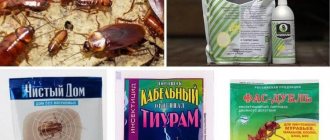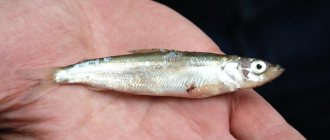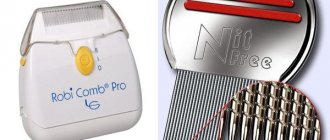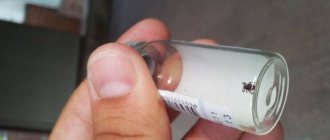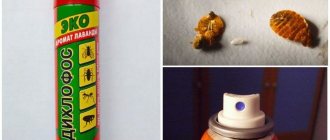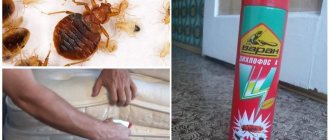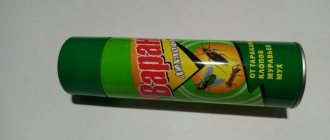Insect control has long become a daily occurrence in the modern world. There are many products that are used for different purposes: getting rid of parasites in the house or in nature (in vegetable gardens, garden plots). The most famous and widely used drug is dichlorvos.
This remedy has been so popularized since Soviet times that in our time it has already become a household name for many people. You should understand in detail what kind of remedy this is, whether it can harm people and what actions to take if the toxin enters the body.
What is it and what is it used for
Dichlorvos is a broad-spectrum insecticide against flying and crawling insects in industrial, commercial and residential premises.
The original composition of Dichlorvos was very dangerous, but now it is produced differently. The current formula uses pyrethroids instead of dangerous toxins, making the insecticide more gentle. The effectiveness was not affected by this, but for humans Dichlorvos is now not as dangerous as before.
In stores you can find its varieties with the same name, but with explanatory prefixes - Neo, Eco, Super, etc.
So is it possible to be poisoned by Dichlorvos if the pyrethroids that became the basis of its composition are low-toxic and not so dangerous for humans? Considering that the drug remains a chemical agent, under certain conditions it is possible to be poisoned by Dichlorvos.
Recommendations
- ^ a b
"Dichlorvos".
Haz card
. US National Library of Medicine. August 2015. Retrieved 2015-10-13. - Das S (2013). "Review of the toxicity of dichlorvos to fish." Current World Environment Journal
.
8
(1). Doi:10.12944/CWE.8.1.08. - “Which pesticides are banned in Europe?” (PDF). pan-europe.info
. 2008. - Gillett JW, Harr JR, Lindstrom FT, Mount DA, St Clair AD, Weber LJ (1972). "Evaluating the Human Health Hazards of Dichlorvos (DDVP), Particularly in Resin Strips." Remnant Reviews
.
44
: 115–59. Doi:10.1007/978-1-4615-8491-9_6. ISBN 978-0-387-05863-4. PMID 4576326. - Pancetti F, Olmos S, Dagnino-Zubiabre A, Rosas S, Morales B (December 2007). "Noncholinesterase effects induced by organophosphorus pesticides and their relationship with cognitive processes: implications for acylpeptide hydrolase action." Journal of Toxicology and Environmental Health, Part
B.
10
(8): 623–30. CiteSeerX 10.1.1.334.9406. Doi:10.1080/10937400701436445. PMID 18049927. - Booth ED, Jones E, Elliott BM. (December 2007). "Review of the genotoxicity of dichlorvos in vitro and in vivo". Regulatory toxicology and pharmacology
.
49
(3): 316–26. doi:10.1016/j.yrtph.2007.08.011. PMID 17936460. - Espeland, M., Irestedt, M., Johansson, K. A., Akerlund, M., Berg, J. E., Kellersjö, M. (January 2010). "Exposure to dichlorvos interferes with the extraction and amplification of insect DNA in museum collections." Frontiers of Zoology
.
7
: 2. Doi:10.1186/1742-9994-7-2. PMC 2819063. PMID 20148102. - Mennear JH (June 1998). "Dichlorvos: a regulatory puzzle." Regulatory toxicology and pharmacology
.
27
(3): 265–72. Doi:10.1006/RTph.1998.1217. PMID 9693077. - "Dichlorvos (DDVP): exclusion of certain applications and directions." US Environmental Protection Agency: Office of Pesticide Programs. April 19, 1995 pp. 19580–19581. Paper control number OPP-38511.
- Vina M (September 11, 2014). “Pesticide levels in waterways have dropped, reducing risks to people.” New York Times
. - Brooks M. (May 17, 2010). "Organophosphate Pesticides Associated with ADHD." Medscape
. - Bouchard MF, Bellinger DC, Wright RO, Weiskopf MG. (June 2010). "Attention-Deficit/Hyperactivity Disorder and Urinary Organophosphate Pesticide Metabolites" (PDF). Pediatrics
.
125
(6):e1270-7. Doi:10.1542/pedy.2009-3058. PMC 3706632. PMID 20478945. - Raeburn, P. (August 14, 2006). "Slow acting." Scientific American
. Vol. 295 no. 2. paragraph 26. doi:10.1038/scientificamerican0806-26. - ^ a b
NIOSH Pocket Guide to Chemical Hazards. "#0202". National Institute of Occupational Safety and Health (NIOSH). - “The preferential effect of Dichlorvos (Vapona) on bacteria deficient in DNA polymerase” (PDF). Cancer Research
. - "A Grand Court Victory for Public Health." www.nrdc.org
. - ^ a b
"Dichlorvos".
Immediately hazardous to life and health (IDLH) concentrations
. National Institute of Occupational Safety and Health (NIOSH). - Brunner, John (1972). Sheep look up
. New York: Ballantine Books. p. 220. ISBN 978-0-06-010558-7. LCCN 72-79705.
Causes of poisoning
Dichlorvos can be poisoned in three ways: by ingestion, on the skin, or by inhalation of its vapors. This happens for a number of reasons:
- treatment of premises without special form and ventilation,
- intentional ingestion or subcutaneous injection for the purpose of committing suicide,
- the chemical accidentally ended up in the hands of children,
- children, pregnant women and animals were not evacuated from the premises at the time of treatment.
Dichlorvos is assigned hazard class 3, which indicates its low toxicity, so you can only become poisoned by it due to your own carelessness. An amount of insecticide equal to 0.5–2 g can be a lethal dose.
Properties, characteristics and applications
Before considering the main symptoms and features of the treatment of poisoning with this drug, you should know that Dichlorvos is an insecticide belonging to the class of organophosphorus substances. The advantages of the product include:
- rapid impact on various types of ticks and insects;
- relatively low toxicity to humans;
- good decomposition under environmental influences;
- no harm to plants.
However, this product also had some disadvantages, which were as follows:
- when treating a room, the substance must subsequently take a long time to erode;
- the possibility of poisoning by the drug due to the fact that it is classified as an organophosphorus compound that can cause serious disorders of the central nervous system;
- harm to humans in case of poor ventilation of the room.
Important! If this substance enters the human stomach, a dose of 0.5-1 gram is lethal.
The above-described shortcomings led to the fact that the drug was simply banned for use, and this ban is still in effect. The same insect repellents that are currently actively produced under the Dichlorvos brand contain permethrin and derivatives of this substance. But it is possible to be poisoned by them even today.
Symptoms
Signs of Dichlorvos poisoning depend on how the insecticide entered the body.
If the product gets on the skin, the victim may experience:
- burning,
- redness,
- tingling,
- signs of allergy (itching, swelling, etc.).
If Dichlorvos gets into the eyes due to careless spraying, the following will appear:
- redness of the membrane,
- itching and pain,
- increased lacrimation,
- conjunctival discharge.
Vapor poisoning will cause the following symptoms in a person:
- headache,
- dizziness,
- runny nose,
- cough,
- respiratory tract irritation,
- temperature 38–39 °C,
- loss of coordination
- nausea with uncontrollable vomiting.
Read also: Bananas during poisoning
Symptoms of Dichlorvos poisoning when ingested are the most severe compared to the previous ones:
- painful vomiting,
- diarrhea,
- increased sweating,
- blurred vision,
- difficulty breathing,
- convulsions.
In addition to the general symptoms described above, there are stages of Dichlorvos poisoning. They can be used to judge the severity of the victim’s condition.
Can dichlorvos harm humans?
If we look at aerosol cans called dichlorvos, we can notice the presence of pyrethroids in the composition. Auxiliary components include preservatives, alcohol and hydrocarbons.
For insects, pyrethroids pose a great danger, as they can cause paralysis and death in just a few hours. They can cause minor harm to humans. While in the human body, under the influence of the liver, permethrins break down into metabolites that are safe for humans. As a result, dichlorvos poisoning is possible, although the probability is low.
Read also: Top ways to comprehensively cleanse the body and remove salts from the body
Stages of poisoning
There are only 3 stages of Dichlorvos poisoning, and each of them is characterized by its own symptoms:
- Stage of increased arousal. It appears after a few minutes, begins with an inexplicable surge of strength (the person literally rushes from side to side), but this is accompanied by an inability to control movements. Blood pressure rises, pupils constrict, and tachycardia develops. The victim becomes dizzy and has a migraine. The salivary glands work in an enhanced mode (saliva drips from the mouth).
- Stage of coordination disorders. Appears after a few hours. The patient's condition as a whole worsens. The urge to go to the toilet becomes more frequent, while urination and defecation are accompanied by pain. It is difficult for a person to breathe, vision becomes blurry, tremors of the limbs and body convulsions appear, saliva is already flowing in a continuous stream. Gradually the poisoned person falls into a stupor. In the absence of help, pulmonary edema develops and death occurs.
- Paralytic stage. A person loses consciousness, all reflexes are lost, paralysis of muscles and breathing occurs. Blood pressure drops and bradycardia develops. If you do not help in time, the victim will die within a day or earlier.
In children, due to their still fragile immunity, all signs of poisoning develop much faster, so you need to call a doctor at the first signs of intoxication.
Regulation
The US Environmental Protection Agency has reviewed the safety data for dichlorvos several times.[8] In 1995, a voluntary agreement was reached with the supplier, Amvac Chemical Corporation, which limited the use of dichlorvos in many, but not all, household, all airborne and other applications.[9] Additional voluntary cancellations were implemented in 2006, 2008 and 2010. The focus is on acute and chronic toxicity and the fact that this pesticide is widely distributed in urban waterways.[10] A 2010 study found that every 10-fold increase in urinary organophosphate metabolite concentrations was associated with a 55-72% increase in odds. ADHD in children.[11][12][13]
First aid
To successfully resolve the problem, quick and competent actions of everyone who is close to the victim are important. In case of Dichlorvos poisoning, all symptoms will depend on the route through which the insecticide entered the body, and this must also be taken into account when providing assistance.
If Dichlorvos gets into your eyes, they should be thoroughly rinsed under running water or a 2% soda solution (1 teaspoon per 1 glass of water). Saline solution can be used for the same purpose. If the eyes are red, after rinsing, you need to instill anti-inflammatory drops, apply a bandage and consult an ophthalmologist.
If Dichlorvos gets on the skin, treat the affected area with a 2% soda solution or wash with soap and water. It is forbidden to rub the place where the poison has entered, since mechanical action on irritated skin allows toxins to penetrate even deeper.
Read also: Salmonellosis in bird eggs
A victim who has inhaled Dichlorvos vapor should be quickly evacuated to fresh air, rinse the nostrils and mouth with water. The patient must remove all clothing that has been in contact with the insecticide and may also have a poisonous effect. After this, put the person to bed and provide him with peace.
If some of the poison gets inside, first aid for Dichlorvos poisoning should be provided especially quickly and carefully:
- give the victim plenty to drink,
- make him vomit
- give any sorbents,
- an hour later - saline laxative medicine,
- do an enema (if you have the skill),
- ensure frequent and abundant drinking (teas, jelly, water are suitable),
- create conditions for bed rest and rest,
- further, monitor the patient’s compliance with a special diet, including light food (and be sure to give kefir, which perfectly restores intestinal flora).
Thus, all assistance measures should be aimed at removing toxins and further alleviating the patient’s condition.
If an allergic person suffers from Dichlorvos, you should urgently give him antihistamines (Suprastin, Tavegil, as well as ointments for skin lesions). If a child under 1 year of age has been poisoned, calling a doctor is necessary in any case.
Mild poisoning with Dichlorvos does not require medical intervention and usually goes away on its own in 2-3 days. But there are situations when the victim needs professional help, which can only be provided in a hospital department.
Treatment
An ambulance team arriving on call will necessarily hospitalize a person if his condition, in the opinion of doctors, requires it. The doctor will determine what to do in case of poisoning in each specific case, but basically these will be the following measures:
- gastric lavage with a probe (if necessary - twice),
- elimination of seizures,
- Alox or atropine sulfate as an antidote,
- therapy to maintain cardiac function,
- antibacterial drugs to avoid the development of secondary infection,
- Ventilation for breathing problems.
Symptoms and treatment after Dichlorvos poisoning are closely interrelated, and all therapeutic actions will be carried out depending on the routes of penetration of the poison and the patient’s condition.
Consequences
Health problems as a result of exposure to Dichlorvos can appear both immediately after poisoning and after some time. In this regard, complications and long-term consequences are distinguished.
Complications develop within two weeks after intoxication and lead to the following diseases:
- dystrophy of the heart muscle,
- toxic hepatitis,
- nephropathy,
- pneumonia.
Read also: Poisoning in nursing mothers
Long-term consequences develop within 3 years after Dichlorvos poisoning:
- damage to the peripheral nervous system (polyneuritis),
- disruption of the autonomic system, leading to dysfunction of internal organs (astheno-vegetative syndrome),
- combined inflammation of the spinal roots and spinal cord (myeloradiculitis).
The consequences of intoxication during pregnancy will be no less serious. If a woman in early pregnancy is poisoned, this can cause fetal death. It is not recommended to contact Dichlorvos in the later stages, as this can also be fatal for the unborn child.
Have you ever been poisoned with dichlorvos?
- Yes it was
- No, it was not
- Now there are symptoms of intoxication
ResultsPoll Options are limited because JavaScript is disabled in your browser.
- No, there was not 59%, 180 votes 180 votes 59% 180 votes - 59% of all votes
- Currently there are symptoms of intoxication 29%, 89 votes 89 votes 29% 89 votes - 29% of all votes
- Yes, there were 12%, 36 votes 36 votes 12% 36 votes - 12% of all votes
Total votes: 305 08/12/2017 You or from your IP have already voted. Vote
- Yes it was
- No, it was not
- Now there are symptoms of intoxication
You or from your IP have already voted. results
Use
Dichlorvos is effective against fungus flies, aphids, spider mites, caterpillars, thrips, and whiteflies in greenhouses and outdoors. It is also used in the flour milling and grain processing industries, and for the treatment of various parasitic worm infections in animals and humans. It is fed to livestock to control flying larvae in manure. It acts against insects as a contact and stomach poison. It is available as an aerosol and soluble concentrate. It is also used in pet collars and "pest-free strips" in the form of pesticide-impregnated plastic; this material has been available to households since 1964 and has been the source of some concern, in part due to misuse.[4]
Prevention
All preventive measures come down to following simple rules:
- Treat premises with Dichlorvos only in a protective form (all parts of the body must be covered and a respirator must be worn).
- When spraying and after it, the room should be well ventilated.
- Do not use Dichlorvos if you are pregnant or prone to allergies.
- When spraying an insecticide at home and for another 4–6 hours after that, all people and animals should be removed from the room (especially children, pregnant women, allergy sufferers, and the elderly).
- After treatment, all work surfaces must be washed (tables, door handles, armrests, etc.).
- Buy Dichlorvos only in the store (not in dubious markets where a lot of clandestinely produced goods are sold).
- Keep dangerous substances away from children.
- If you have no experience in disinfestation, do not carry it out yourself (call SES employees).
Since the composition of modern Dichlorvos is relatively safe, poisoning with this chemical can only be done intentionally or in case of gross violations of the rules of use. With a responsible approach and understanding that the work is carried out with chemicals, cases of intoxication are excluded.
How to use dichlorvos
This insecticide is very effective in killing various types of pests. The drug is universal, that is, it will help get rid of both crawling and flying pests, as well as most household parasites. In the instructions for the product you will find information about its use at home, consumption standards, as well as safety recommendations. Compliance with the nuances specified in the annotation is mandatory.
Instructions for use for getting rid of lice
Before using dichlorvos to combat lice and nits, it is necessary to take certain protective measures. First of all, this is the use of special accessories, such as:
- latex gloves,
- medical mask or respirator,
- closed clothes.
Using dilofos you can get rid of lice
Lice and nits
Immediately before etching, the container with the drug must be shaken. Next, you need to take a thick plastic bag and inject a small amount of insecticide into it (two or three pumps are enough). After the product has been applied to the inner walls of the bag, put the bag on your head and wrap it with a towel. During the procedure, you must be extremely attentive and careful; it is important to ensure that the bag does not touch open areas of the skin. Again, make sure that the drug does not come into contact with the skin of your hands. Getting dichlorvos into the human respiratory tract is also very dangerous!
It is strictly forbidden to use this method on pregnant women, children, people with any respiratory diseases, as well as in case of individual intolerance to the insecticide.
After 15–25 minutes, the headband can be removed. It often happens that during the procedure the head itches and itches: they say that this is normal - the parasites begin to bite hard in agony. Immediately after the procedure, you should rinse your hair two, or even better, three times. This is the only way you can completely remove the drug from your hair and skin. Finally, you need to carefully comb out dead insects from your scalp.
According to the author of the article, this method is still not worth using. To destroy nits and lice in hair, today there are a lot of effective and safe medications for humans.
Body lice
Dichlorvos also works effectively against body lice. An aerosol is used to thoroughly treat things where parasites are found, but it is also necessary to comply with existing safety measures, the main one of which is the use of protective gloves and a respirator.
Body lice can be eliminated very quickly at home. To do this, you need to treat all things with dichlorvos and pack them in sealed plastic bags. After the procedure, a period of time equal to ten to twenty minutes is maintained. Upon completion, it is necessary to thoroughly ventilate the items and wash them at high temperatures using active detergents.
How to use for flea control
Dichlorvos effectively destroys fleas, but its use is permissible only after eliminating the cause of the appearance of insects in the house. Often the latter are brought into the apartment by pets (dogs and cats). After treating the animals, you can begin to disinfect the premises.
The fight against fleas indoors with pets begins with treating the latter
All surfaces in the house are sprayed with dichlorvos, paying special attention to the following items:
- floors,
- wardrobes,
- shelves littered with things.
Windows and doors are closed the day before treatment. During disinfestation, all residents, as well as pets, must leave the apartment. After treatment, the room must be closed and waited. A few hours after the procedure, thoroughly ventilate and carry out wet cleaning.
If there are a lot of fleas in the house, the treatment will have to be repeated. This is done no earlier than two weeks after the first disinfestation, since it is after this period of time that the young animals will hatch from eggs that are resistant to many poisons.
How to use against bedbugs and other pests
Soviet dichlorvos worked very effectively in poisoning bedbugs and other insects; modern analogues cope with pests and parasites no worse. However, before carrying out large-scale treatment, it is important to identify the places where bedbugs are most concentrated. It is necessary to consider all potential places where they can be found, for example:
- upholstery of upholstered furniture,
- wood products (especially interior spaces),
- areas under baseboards.
The product can be used against bedbugs and other pests.
The indicated and other potentially dangerous areas must be treated first. The contents of the cylinder are sprayed over all surfaces, paying special attention to bedroom furniture, mattresses and sofa cushions. The undersides of carpets and the back surfaces of furniture are processed methodically from all sides. It is claimed that the drug does not leave any stains on fabrics and surfaces.
Sometimes bedbugs cannot be removed from an apartment during one disinsection; in this case, the procedure must be repeated after a few days. We should not forget that with repeated use, parasites get used to dichlorvos. Fleas can also migrate to another apartment during disinfestation and then return back.
Read more about dichlorvos for bedbugs in our article - Dichlorvos for bedbugs - a new remedy under the old name.
Cockroaches
In cockroaches, dichlorvos causes damage to the chitinous shell, destruction of the digestive and respiratory organs, and as a result - complete paralysis and death. For a more effective result, it is advisable to spray insects directly and places where they are concentrated. Particular attention should be paid to places such as:
- kitchen cabinets and spaces behind them;
- gaps between and under furniture;
- the insides of carpets;
- areas around the sink and washbasin;
- batteries and pipes, as well as areas adjacent to them;
- baseboards and walls.
Dichlorvos effectively destroys cockroaches.
Cockroaches, like bedbugs, can migrate to your neighbors using ventilation lines. To increase efficiency and to prevent the appearance of pests, dichlorvos is recommended to be used together with insecticidal traps or pencils. If there are too many cockroaches in the apartment, the treatment of the premises must be repeated.
According to the author, baiting cockroaches in an apartment using dichlorvos is an outdated and far from safe method. You can destroy or expel pests using specialized gels, traps and repellers.
Ants
To eliminate ants in your home, you must first locate their nests. Dichlorvos is sprayed directly onto ant dwellings, following the processing rules specified in the instructions for the drug. The balloon should be kept at a distance of 30 centimeters from the surface; shelves in the kitchen, window glass, frames and doors should also be sprayed with a spray can. If the anthill is out of reach, the pests can be lured. To do this, treat small pieces of sugar with the product and place them around the rooms. Using this method, you can eliminate the colony completely.
Flying pests
The procedure for exterminating flying insects is somewhat different from disinfestation measures aimed at crawling pests. Thus, an aerosol can be used to treat the habitats of flies, moths, mosquitoes and other insects. The substance is sprayed into the air throughout the room, not forgetting about safety precautions. In the case of moths, wardrobes and things placed in them are sprayed with insecticide.
For more information on how to fight moths, read our article - How to get rid of moths in an apartment.
Dichlorvos can also be successfully used to destroy creatures that encroach on indoor plants.
